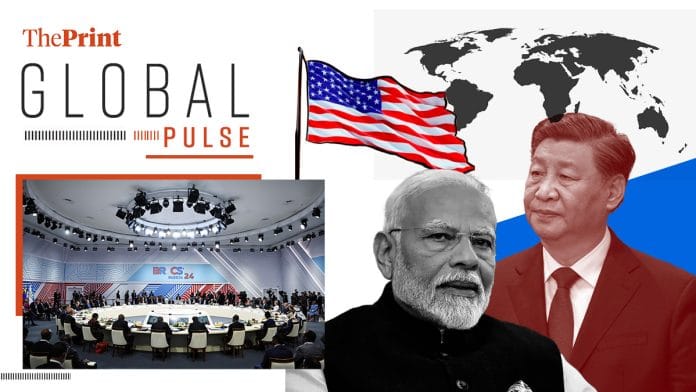New Delhi: The first bilateral meeting between Xi Jinping and Narendra Modi in over five years at the BRICS Summit is of huge “strategic significance” as the recovery of ties between India and China serves not just themselves, but also the “multi-polarization” of the world order, reports Global Times.
It quotes the deputy director of a Chinese university as saying Indian policymakers have realised that spending the “past four years decoupling from China and trying to get support from the US” is a “mistake”—which India now has to correct, of course.
India hasn’t been able to receive “meaningful support” from the US to aid in India’s modernisation and industrialisation, according to Global Times. This proves that India “can’t profit” from being hostile towards China, the article says, condensing four years of a strained relationship and four years of industrial growth into its dismissal of India’s economy. China+1 strategy—and the subsequent relocation of certain manufacturers like Foxconn to India—might as well never have happened.
“This means that Modi may finally realise that it is unwise for India to completely side with the US in this game of great powers,” the Global Times piece says hopefully.
The New York Times reports the meeting as signalling the “prospect of a potential thaw”. Frosty relations seem to be melting away between the “two Asian powers”, a report states, especially following the recent border patrolling agreement.
“Both leaders underscored their desire for a more ‘multipolar’ world, an inference to the current global order, where the United States dominates, wielding what China and India regard as unfair influence,” the report observes.
But the BRICS has “struggled to speak with a unified voice,” the report states—largely because China and India are locked in eternal competition.
“China wants to use the grouping to weaken the dominance of the United States and burnish its credentials as a leader of the so-called Global South,” the NYT writes. “India also claims leadership of the Global South, but unlike China, remains firmly nonaligned and does not want BRICS to develop into an explicitly anti-Western body.”
India’s alleged nonalignment will come as a surprise to Global Times, then.
The NYT also takes aim at China: easing tensions with India will help drive a wedge between New Delhi and Washington, it writes, and will “provide Beijing with one less headache at a time when it is struggling to turn around its sputtering economy, which has been battered by a property crisis.”
The NYT report ends with thoughtful reflection on the exact position India occupies on the global stage. “Indian foreign policy has long been defined by its overlapping and sometimes contradictory set of friends,” it observes, locating India as a member of both the Quad and the SCO.
Either way, it says, Indo-American relations have been accelerated over the past decade—“as India has been drawn into greater and greater economic, technological and military coordination with Washington”.
In its story on the meeting, the Financial Times writes that Xi is “keen” on using groups like BRICS to “promote his agenda of creating an alternative world order, even though it includes democracies such as India and Brazil that have better relations with Washington.”
Reuters also has a story on the significance of India and China’s meetings. BRICS will simply remain “for the fairies until India and China get serious,” its headline claims.
This particular opinion comes from then-Goldman Sachs chief economist Jim O’Neill, who introduced the term BRIC in a 2001 research paper. Calling him Mr. BRICS, the Reuters reports that unless India and China put aside their divisions and cooperate on trade, the alliance is simply a fantastical arrangement.
Saying BRICS has achieved very little in the past 15 years, O’Neill told Reuters that, so far, the summit seems to be a “symbolic annual gathering where important emerging countries, particularly noisy ones like Russia, but also China, can basically get together and highlight how good it is to be part of something that doesn’t involve the U.S.”
In the same way that global issues can’t be solved without the US and Europe, he said, it’s impossible for the West to solve global problems without India and China—and to a lesser extent, Russia and Brazil, he adds as an afterthought.
The potential of BRICS, then, can only be realised if India and China work together. Bringing in more members will achieve nothing, Reuters reports.
Also read: Global media on China and Russia’s ‘profound friendship’ & Ripudaman Singh’s killers coming to blows






